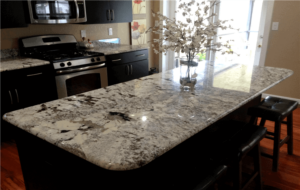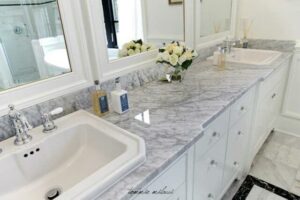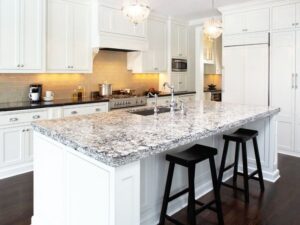The decision to incorporate marble or onyx into a bathroom is a commitment to unparalleled luxury. The swirling veins of Calacatta marble or the ethereal, translucent layers of a backlit onyx countertop transform a functional space into a personal sanctuary, a testament to timeless style. For luxury homeowners and discerning bathroom remodelers in Florida, these natural stones are a signature of sophistication and a significant investment in a property’s value and appeal. However, the Sunshine State’s notorious humidity, a constant, invisible presence, can be a formidable foe to these porous materials. Without a proactive and consistent protection plan, your beautiful investment can become susceptible to staining, etching, and moisture damage that can be difficult and costly to reverse. This comprehensive guide will provide you with the essential knowledge for sealing a marble bathroom and how to protect an onyx countertop, ensuring their longevity and brilliance despite the unique challenges of Florida humidity stone care.
The Why: Florida’s Climate vs. Natural Stone
To understand why these stones are vulnerable, we have to look at their geological origins. Marble is a metamorphic rock formed when limestone is subjected to immense heat and pressure. Onyx is a sedimentary rock formed in caves as water drips and deposits minerals. Both are calcite-based stones, meaning they are primarily composed of calcium carbonate. This geological makeup makes them inherently softer and more porous than siliceous stones like granite. Think of the surface not as a solid, impenetrable shield, but as a dense sponge with millions of microscopic pores and capillaries. In the warm, damp environment of a bathroom, these pores readily absorb liquids and harbor moisture.
Florida’s high humidity exacerbates this issue by creating a constantly moist environment where surfaces rarely have a chance to fully dry out. This creates a perfect breeding ground for a host of problems that can permanently mar the stone:
- Staining: It’s not just water that gets absorbed. The pores will gladly welcome spills from colored liquid soaps, shampoos containing dyes, makeup, hair products, and even some lotions. Once these agents seep deep into the stone’s structure, they cause stubborn discoloration that can be difficult or impossible to remove, leaving a permanent “ghost” of the spill.
- Etching: This is fundamentally different from a stain and is arguably the more common issue in bathrooms. Etching is a corrosive chemical reaction that occurs when acidic substances come into contact with the calcium carbonate in the stone. The acid literally eats away at the surface, dissolving the polished finish and leaving a dull, whitish mark that looks like a water spot or a splash mark that can’t be wiped away. Common culprits in a bathroom are plentiful: vinegar, citrus-based cleaners, many toilet bowl cleaners, and most “anti-limescale” or “hard water” removers. Even some “natural” cleaning solutions can cause irreversible damage.
- Mold and Mildew: The constant moisture in the air, combined with soap residue (which acts as a food source), can lead to the growth of mold and mildew within the stone’s pores and, more commonly, in the surrounding grout lines. From the grout, it can easily migrate into the stone itself. This is not only unsightly, creating dark, splotchy patches, but it can also pose a health concern and produce a persistent musty odor that permeates the entire bathroom.

Choosing Your Weapon: The Best Sealers for the Job
Sealing your marble and onyx is the most critical, non-negotiable step in protecting them. A good sealer creates a protective, sub-surface barrier, filling the pores to prevent liquids and moisture from penetrating the stone. There are two main categories of sealers, but only one is truly suitable for a wet, humid environment.
- Penetrating/Impregnating Sealers: This is the correct choice for a bathroom. As the name suggests, these sealers have a carrier (either water or a solvent) that allows microscopic resin particles—often advanced fluoropolymers—to soak deep into the stone. The carrier evaporates, leaving the resin behind to clog the pores from within. This creates a durable, invisible shield that is breathable, allowing any moisture that might get trapped in the stone to escape naturally as vapor. This breathability is paramount in a humid climate.
- Topical Sealers/Coatings: These products form a film on the surface of the stone, much like a varnish on wood. While they can offer good initial protection, they are a poor choice for a bathroom because they trap moisture. In Florida’s humidity, this trapped moisture can cause the stone to appear cloudy and can even lead to spalling, where the surface of the stone begins to flake off. Furthermore, topical coatings can yellow over time, scratch easily, and are very difficult to strip and reapply without potentially damaging the stone underneath.
Within the recommended category of penetrating sealers, you’ll find two primary formulations:
- Water-Based Sealers: These modern formulations have low VOCs (volatile organic compounds), making them a safer, low-odor choice for indoor projects. They are highly effective, and their technology has advanced to the point where they often perform as well as, or better than, their solvent-based counterparts. They are an excellent option for a sealing marble bathroom project. Cleanup is also simple, typically requiring just soap and water.
- Solvent-Based Sealers: These traditional sealers offer very deep penetration and durability. However, they have a strong chemical odor and require significant ventilation during application, making them less practical for an enclosed bathroom space.
For a Florida bathroom, a high-quality, water-based penetrating sealer is your best bet. Look for a premium product that is specifically formulated for marble and other natural stones and offers both oleophobic (oil-repellent) and hydrophobic (water-repellent) properties.
The How-To: A Step-by-Step Guide to Sealing
1. The Water Test: Not sure if your stone needs sealing? The test is simple. Place a few drops of water on the surface in an inconspicuous area. If the water beads up tightly, your current sealer is still working. If the water seems to spread out, darkens the stone, or is absorbed within a few minutes, it’s time to seal.
2. Prepare the Surface:
- Clean Thoroughly: The stone must be impeccably clean. Use a pH-neutral cleaner specifically designed for natural stone to remove any dirt, grime, or soap scum. Soap scum is particularly important to remove, as it can block the sealer from penetrating the pores. For stubborn areas, use a soft nylon brush. Rinse the surface thoroughly with clean water to remove all cleaner residue, then dry with a cloth.
- Dry Completely: This is a crucial step that cannot be rushed. Allow the stone to air dry for at least 24-48 hours after cleaning. It’s not just the surface that needs to be dry; the moisture within the stone’s pores must also evaporate. Using fans can help accelerate this process. Sealing damp stone will trap moisture and cause a hazy, cloudy appearance.
3. Application:
- Ventilate the Area: Even with low-VOC sealers, it’s important to have good airflow. Open windows and use fans to ensure proper ventilation.
- Apply the Sealer: Using a clean, lint-free microfiber cloth, an applicator pad, or a soft-bristled brush, apply the sealer liberally in a thin, even coat. Work in small, manageable sections (e.g., 3×3 feet) to maintain control. The goal is for the stone to look uniformly wet but not puddled.
- Let it Penetrate: Allow the sealer to sit on the surface and “dwell” for the time recommended by the manufacturer (usually 5-15 minutes). During this time, you may see some areas absorb the sealer more quickly. You can reapply a small amount to these “thirsty” spots to ensure even coverage.
- Remove ALL Excess: Before the sealer begins to dry on the surface, wipe away every bit of excess with a clean, dry cloth. This step is critical. If you leave excess sealer to dry on the surface, it will create a hazy, streaky film that is very difficult to remove. If you do get a hazy spot, you can often remove it by applying a little more sealer to re-wet the area, which will dissolve the residue, and then immediately buffing it dry.
- Cure: The sealer needs time to fully cure, which is the chemical process of the resin molecules bonding with the stone. This can take anywhere from 24 to 72 hours, depending on the product and ambient humidity. During this curing period, the surface must be kept completely dry and protected from spills and heavy use.

Maintaining the Shine: Long-Term Care
Sealing is not a one-and-done task. A consistent maintenance routine is key to preservation.
- Daily Care: Use a squeegee on shower walls after every use. Wipe down countertops and vanities with a dry microfiber cloth to remove any standing water or spills. Use coasters for toiletries, especially those in dark-colored bottles.
- Blot, Don’t Wipe: When spills happen, blot them immediately with a paper towel. Wiping can spread the spill and push it into the stone’s pores.
- Weekly Cleaning: Use a pH-neutral stone cleaner for a more thorough cleaning. This will remove soap scum and residue without damaging the stone or the sealer.
- Avoid All Harsh Chemicals: Create a “do not use” list for your bathroom. It should include: vinegar, lemon juice, bleach, ammonia, abrasive powders, and any generic “all-purpose” or “bathroom” cleaners unless they explicitly state they are safe for natural stone.
- Reseal Regularly: In a high-humidity environment like a Florida bathroom, you’ll likely need to reseal your marble and onyx every 6-12 months. High-traffic areas like shower floors may need it more frequently. Perform the water test every few months to check if it’s time to reseal.
By taking a proactive approach to Florida humidity stone care, you can ensure that your marble and onyx surfaces remain as beautiful and luxurious as the day they were installed. This simple routine of care and maintenance is a small price to pay to protect a significant and stunning feature of your home.





